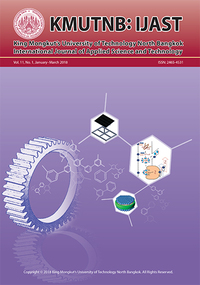Development of Solar Oven for Controlling Fungus in Tea Oil Seeds
Main Article Content
Abstract
The purposes of this research are to develop and investigate the efficiency of solar oven for controlling fungus in tea oil seeds. This research also studies how to effectively roast tea oil seeds using 2 binary tree system with 4 scenarios method which consists of A1B1, A1B2, A2B1, and A2B2. The sample used in this study is 10 kg of tea oil seeds originally from Tea Oil and Plant Oils Development Center in Mae Sai District, Chiang Rai Province. The efficiency testing results show that the solar oven offers the maximum temperature of 69°C and the minimum moisture content of 33%. This solar oven is then used to roast tea oil seeds using 4 different methods for 7 day. The experimental results indicate that the A1B1 roasting method gives moisture content of 7.408%, and drying ratio of 0.440% with no fungus. While A1B2, A2B1, and A2B2 roasting methods provide moisture content of 5.967%, 0.102%, 0.003%, and drying ratio of 0.355%, 0.006%, 0.0001% respectively. The fungi are found at the end of experiments in all three methods.
Article Details
References
[2] Tea Oil and Plants Oil Development Center Chiangrai. (2016, Mar.). We love Thai King. Thailand [Online]. Available: http://welovethaiking. com (in Thai).
[3] W. Sanprasert. (2016, Mar.). Oil Tea. Naewna. Bangkok, Thailand [Online]. Available: http:// www.naewna.com (in Thai).
[4] A. Butdeewong. (2016, May.). Heater. Technology Instruments. Bangkok, Thailand [Online]. Available: http://www.tic.co.th (in Thai).
[5] A. Luemasueni, L. Smarnpituk, and S. Kasor, “Research and design incubator to control temperature the egg back automatically,” YRU Journal of Science and Technology, vol. 2, no. 1, pp. 39–49, 2017.
[6] P. Pornchaloempong and N. Rattanapanon. (2016, Apr.). Drying Ratio. Food Network Solution Co., Ltd. Bangkok. Thailand [Online]. Available: http://www.foodnetworksolution.com (in Thai).
[7] S. Niseng and P. Suaybangdam, “Drying oven for cayenne papper using electric energy coupled with solar energy,” in The 9th National Conference on Technical Education, 2016, pp. 50–54.
[8] K. Poniyom, P. Singrat, and I. Chaorakam. (2016, Apr.). Development of Solar Powered Herb Dryer. Kasetsart University. Bangkok, Thailand [Online]. Available: http://kukr.lib.ku.ac.th (in Thai).
[9] S. Phamonlsmit. (2016, Apr.). Dried Tilapia by Solar Drying with Infrared. Office of the Higher Education Commission. Bangkok, Thailand [Online]. Available: http://tdc.thailis.or.th (in Thai).
[10] Ramathibodi Poison Center, Mahidol University. (2016, Mar.). Mycotoxins. Mahidol University. Bangkok, Thailand [Online]. Available: http:// med.mahidol.ac.th
[11] Tea Oil and Plants Oil Development Center, The Chaipattana Foundation. (2016, Mar.). Tea Oil (Camellia Oleifera Abel). The Chaipattana Foundation. Chiang Rai, Thailand [Online]. Available: http://www.teaoilcenter.org


